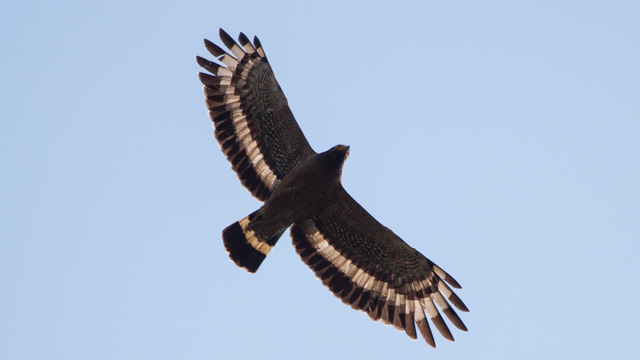
The Annapurna Base Camp Trek is an amazing place for bird watching. The sheer variety of birdlife is best manifested in the fact that all six Himalayan pheasants (Himalayan Monal, Koklass Pheasant, Cheer Pheasant, Kalij Pheasant, Satyr Tragopan and Blood Pheasant) can be found here. It also kind of helps that the ABC Trek also has one of the premier hawk-watching sites in Nepal.
Start planning your trek to Annapurna Base Camp.
1. Satyr Tragopan

Where to see in your Annapurna Base Camp Trek:
Given that poachers would love the information, no information for this threatened species will be given. But suffice it to say, chances are pretty high that you will hear these birds during your trek.
Description: These large pheasants are more often heard than seen. And what a call it has!! It is a eerie wailing drawn out waah! wah! oooah!! uttered up to 15 times in a crescendo at dawn. Hence the ‘Satyr’ in its name. If you see one after you hear its call, you might be surprised to find a rather pretty crimson bird. While this particular species is the least threatened of all the tragopans, it is nevertheless considered near-threatened.
Scientific Name: Tragopan satyra
Local Name: Munal
Altitude: 2,500-3,800 m(8,202- 12,467 ft) summer; winter down to 2,100 m (6,889 ft)
Habitat: Moist evergreen forest
IUCN Status: Near threatened
2. Crested Serpent Eagle

Where to see in your Annapurna Base Camp Trek:
These guys could show up after the day heats up just about anywhere in the lower stretches, mostly in the Modi River watershed before Ghandruk.
Description: As the name suggests these guys are specialists in hunting down reptiles. It generally does so by waiting in a perch near a clearing rather than soaring. They are generally found close to water and while their diet does include snakes, they also hunt lizards, frogs and also small mammals and birds. In flight they can be told by the pattern on their broad round wings.
Scientific Name: Spilornis cheela
Local Name: Kakakul
Altitude: below 2,100 m (6,889 ft) summer; 915 m (3,001 ft) winter
Habitat: Forest and well wooded country
IUCN Status: Least concern
3. Steppe Eagle
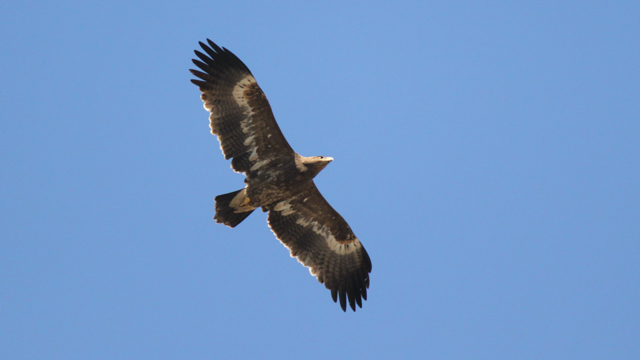
Where to see in your Annapurna Base Camp Trek:
If you are doing the Annapurna Base Camp in fall (late Oct-Nov is the best time) make sure you start your trek through Kande as early as possible. That way you will get to Australian Camp by midday, too see these guys and their pals fly over you.
Description: This large and impressive eagle comes to South Asia from its breeding grounds in the Central Asian Steppes during winter. At certain sites like Australian Camp near Pokhara as many as 300 of these eagles pass by each day during fall migration. During winter they are perhaps the most commonly seen eagles in Nepal and while their conservation status is currently of Least Concern, there is evidence that the drug diclofenac which crashed the vulture population in South Asia is a potential threat to this bird too. Also it is interesting to note that even though these guys are winter migrants to South Asia, its scientific name suggests that it was first recorded from Nepal.
Scientific Name: Aquila nipalensis
Local Name: Gomayu Mahacheel
Altitude: Below 2,200 m (7,217 ft)
Habitat: Wooded hills, open country and lakes
IUCN Status: Endangered
4. Great Barbet
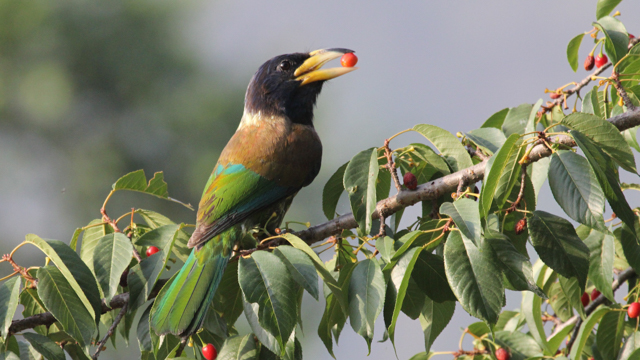
Where to see in your Annapurna Base Camp Trek:
If you are trekking in spring, you will hear these birds call continuously through the night and day.
Other than the call, these birds are usually hard to see because they are shy and well camouflaged. Their call can be heard from the starting of the trek till about Chhomrong.
Description: The Great Barbet produces what is perhaps the most incessant sound of spring and summer in Nepal. Whether you like it or not, you will have to put up with its “pihuuuu, pihuuuu” throughout the day. Local folklore relates this call to the sad yearning of a separated lover and many folk songs pay tribute to the ‘nyauli’ bird (nepali name of Great Barbet) in their lyrics.
If you really want to see one of these birds, you will have to be very patient as they seldom come out of the dense foliage while calling.
Scientific Name: Psilopogon virens
Local Name: Nyauli
Altitude: 900-2,200 m (2,952- 7,217 ft)
Habitat: Subtropical and temperate forest
IUCN Status: Least concern
5. Green-tailed Sunbird
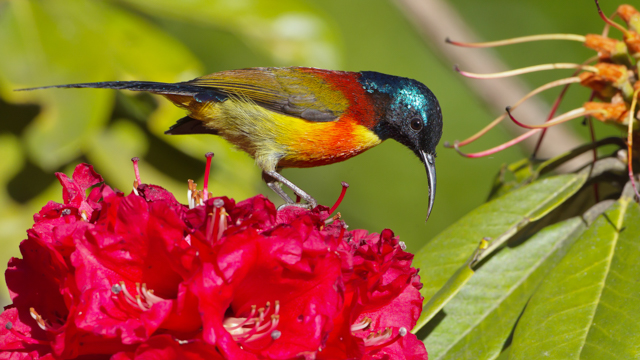
Where to see in your Annapurna Base Camp Trek:
These little birds can be seen as sudden flashes in the sun almost throughout the trek except in the higher regions beyond Dobhan.
Description: Sunbirds are the East’s answer to the hummingbirds. While morphologically very similar to the hummingbirds, this is an example of convergent evolution in which two unrelated species look similar because of identical (nectar-feeding) lifestyles. Also while both hummingbirds and sunbirds can hover, the sunbirds can’t reverse like their New World counterparts. The pendulous hanging nests of sunbirds made from twigs and leaves woven with spider web are rather interesting structures, ideally suited to hold just the lightweights.
Scientific Name: Aethopyga nipalensis
Local Name: Nepal Bunggechara
Altitude: 1,830-3,000 m (6,003- 9,842 ft) summer; 915-2,745 m (3,001- 9,005 ft) winter
Habitat: Oak/rhododendron and mixed forest
IUCN Status: Least concern
6. Common Hill Partridge
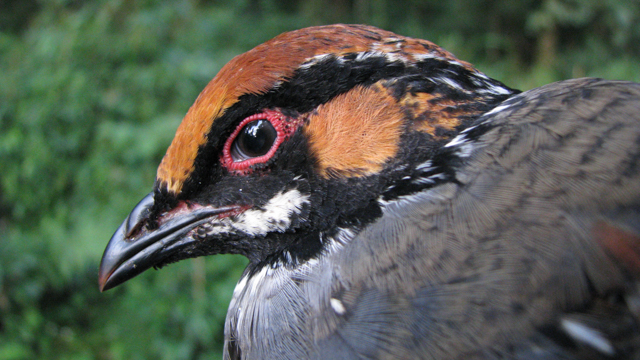
Where to see in your Annapurna Base Camp Trek:
The Dhampus and Ghandruk forests resound with the call of these guys. Again, these guys are more often heard than seen.
Description: These guys are heard frequently in broadleaved forests but are seldom seen. The call that gives out its presence is a drawn out fluty whistle repeated every three-four seconds. They usually go about in pairs or small family parties near ravines or damp forest patches.
Scientific Name: Arborophila torqueola
Local Name: Peura
Altitude: 1,830-3,200 m (6,003- 1,0498 ft)
Habitat: Broadleaved evergreen forest
IUCN Status: Least concern
7. Large Hawk-Cuckoo
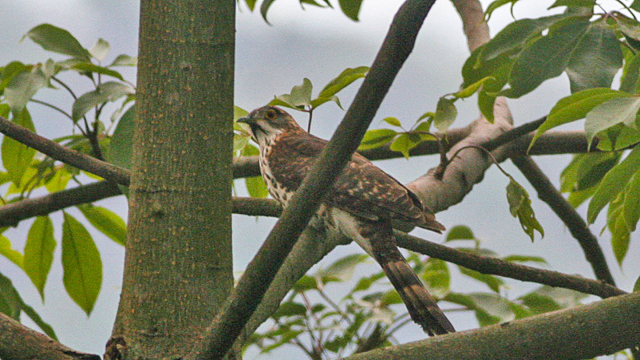
Where to see in your Annapurna Base Camp Trek:
Again if you are trekking during spring, calls from these birds will be your constant companion till about Dobhan.
Description: This is the infamous Brain Fever bird so called because its call goes something like “Braain…….Feebaar……..Braain…….Feebaar” . And it calls relentlessly regardless of day or night and personal preference of those hearing the call.
If you get to see this annoying bugger, you will notice why it is called a Hawk Cuckoo for it looks and flies exactly like a sparrowhawk. Evolutionarily it makes sense because other birds mistake it for a hawk and flee their nests upon seeing it. This makes the job of parasitizing the nests of those gullible birds much easier.
Scientific Name: Hierococcyx sparverioides
Local Name: Pahadi Beu Kuhiyo
Altitude: 1,830-3,000 m (6003- 9,842 ft) summer; 1,800-2,460 m (5,905- 8,070 ft) winter
Habitat: Broadleaved forest
IUCN Status: Least Concern
Plan your Annapurna Base Camp Trek.




